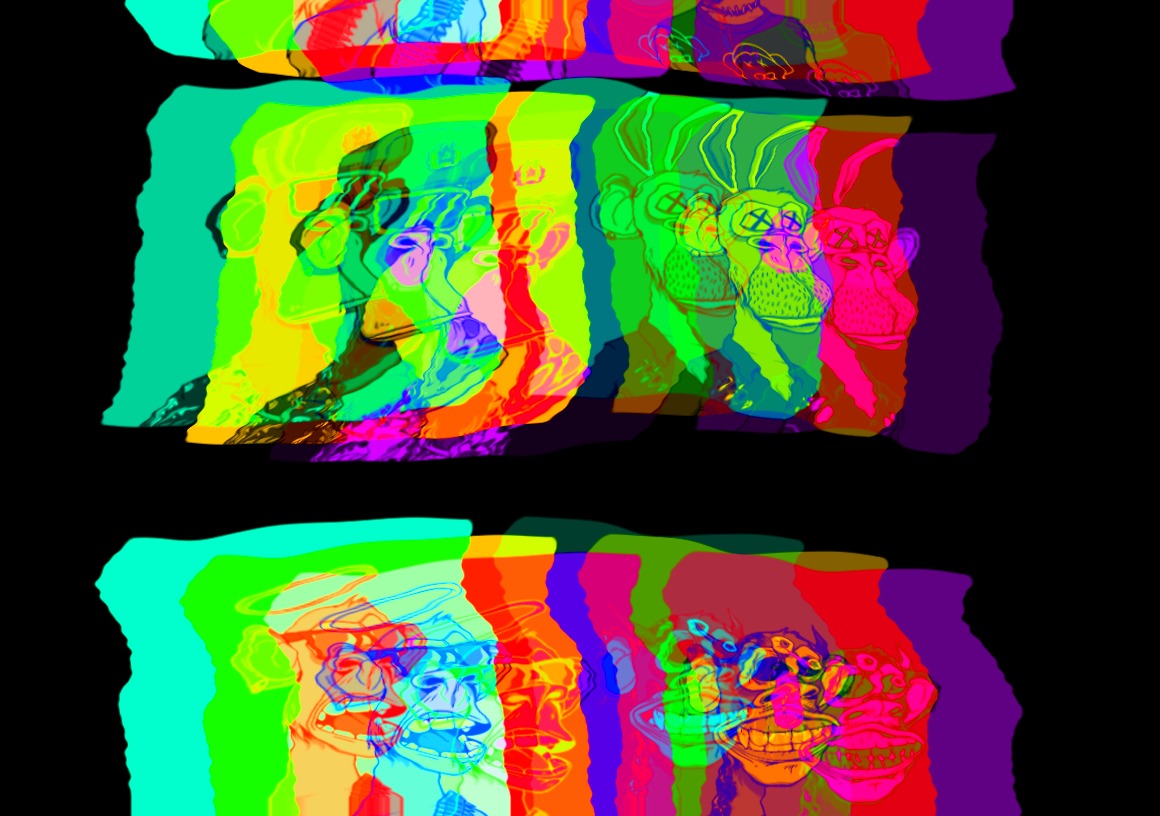30/11/2021 Planet of the Bored Apes
Bored Ape Yacht Club has created an easily mimicked model for mainstream adoption. But that doesn’t mean they’ll remain king of the mountain.

The tech behind NFTs, or non-fungible tokens, hasn’t changed all that much since the development of the ERC-721 standard – the coding framework on which most popular crypto collectibles are built.
That’s because until 2021, NFTs were mostly a niche curiosity for crypto enthusiasts. Even with the rise of CryptoKitties in 2017, NFTs didn’t immediately conjure up any cultural or aesthetic reference points beyond the broader crypto ecosystem – despite becoming a media hang-up.
Arts
 (0)
(0)
 (0)
(0)
https://www.coindesk.com/tech/2021/11/29/planet-of-the-bored-apes/
Interesting NFTs
The Harvest
An anthropomorphic figure stands, wide eyed, staring at the viewer; its body masculine, muscular, and humanoid. Its “mind” dissociates into a conglomerate of structures resembling feathers, grain, teeth–as well as a radial flower “node”, casting linear rays throughout the composition.
To his left, a vat of bodies gesture and writhe in a kind of amniotic soup, attended by a video game robot. The bot's red display reads “uWu”.
Behind the robot and filling the left side of the composition is an archaic figure composed of a variety of vintage objects and symbols. Among them are a hardbound book with ancient cuneiform scripts, indicating barley, beer, bread, ox, house, and sky, behind which is a grimacing, salivating jagged toothed maw; and an old Commodore floppy drive. The figure’s head tilts toward an illuminated crescent moon, suggesting the Egyptian Sacred Bull.
The archaic figure is composed of a variety of mutating cells, which shift in color, and pattern; eventually breaking free into an ephemeral broadcast of bubbles which move across the background.
The work came into being against a psychological introspection, which included associations to pop culture such as alien abduction and pod people, as well as quite a bit of reflection on grains as a symbol of civilization, agriculture, sustenance, life, and imbibing (mainly whiskies).
Lim Hedra #1/20
⏣
Poem by Dainagon Tsunenobu, from the series One Hundred Poems by One Hundred Poets, Explained by the Nurse
Katsushika Hokusai (1760-1849)
Poem by Dainagon Tsunenobu, from the series One Hundred Poems by One Hundred Poets, Explained by the Nurse
late 1830s - Japan
混沌の目
The eye of ChaosYour inner and outer worldsSeeing each other
Alex in Wonderland
A figure, Alex, stands mostly naked in the midst of a physical and psychological maelstrom. He is clad only in nostalgic 80’s era socks, on a tenuous island between active waters and a variety of shark denizens. Sharks on the right side of the image are all beached, including a shark with a quartz crystal snout, an orange shark wrapped in a life buoy, and a shark further in the distance wearing an 80’s style shirt with the number “88”. On the left side is the largest shark, wearing bright glossy red lipstick and brandishing prominent teeth with braces. She is cordoned off from the figure by a roped float divider, and within her thought bubble is a warning symbol.
Behind the figure, hovering in the air, are Grey aliens emerging from the distance, out of a series of elliptical UFO shaped interdimensional membranes. The Greys take on the visual form of spermazoa ostensibly impregnating the interdimensional thresholds. As is typical, these Greys inhabit a zone just behind the unconscious topology of Alex’s dissociative mind.
Though Alex’s bottom half is representative, his top half mutates into a psychological cornucopia. In a manner akin to “Auto-Erotic Sphinx”, a predecessor work, the figure has self suctioned—an act of sensual infatuation, enjoyment, and exploration.
Upward exists the figure’s primary conscious eye, adorned with a revolutionary beret emblazoned with a Bitcoin badge. The figure’s summit features the nose of a fighter jet facing off against video game Bullet Bills, one of whom is marked by a communist North Korean star. A cropped section of a UFO observes the contest.
Alex’s mind branches both left and right. To the left is more singular embodied consciousness, manifesting two eyes and a Ganesh trunk grasping crayons. The right branch dissociates upward diagonally, emerging into an array of eyes, faces, teeth, tail, a unicorn horn, and much more—all of which participate in expressing his unconscious being; a democracy of psychic factions representing thought impressions and associations. All illumination and darkness– fernal, infernal, high consciousness and corporeal underbelly–reside in this realm.
In the distance are relatively languid, light clouds, and against the firmament hovers a colossal distant eye peering over the scene and far beyond.
This painting possesses underlying genetic traits with previous works such as “Auto-Erotic Sphinx with Toys”, “Dionysus”, and “Fuku-Shiva”. The work serves also as a nod to an earlier period of art inspiration during late teens and early twenties— born out of the nakedness, vulnerability, curiosity, and wonder inherent to coming of age and all subsequent psychedelic revelation.